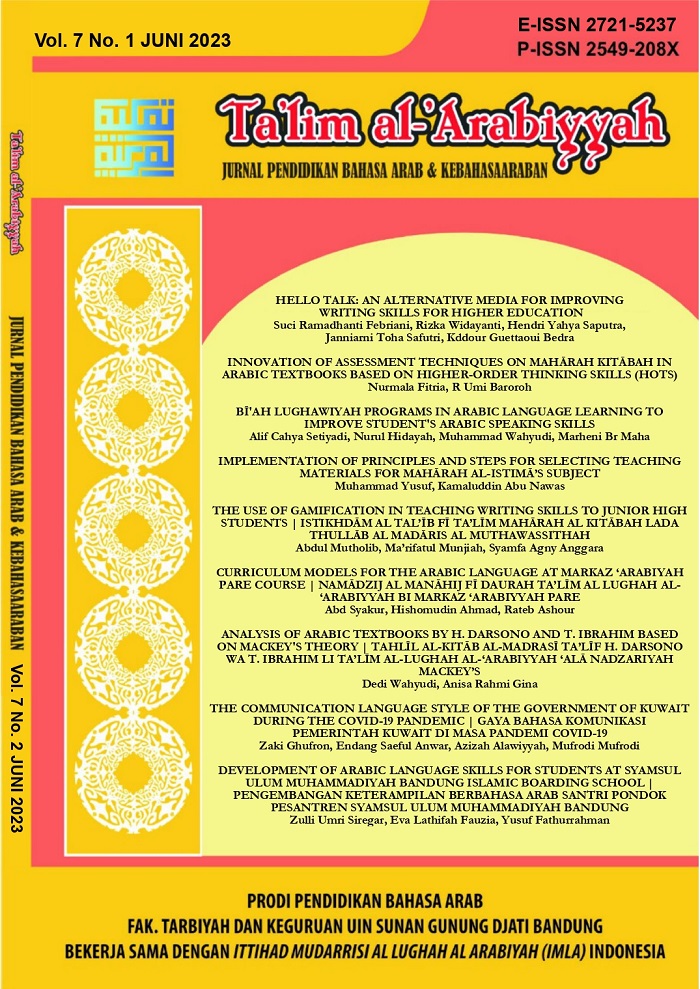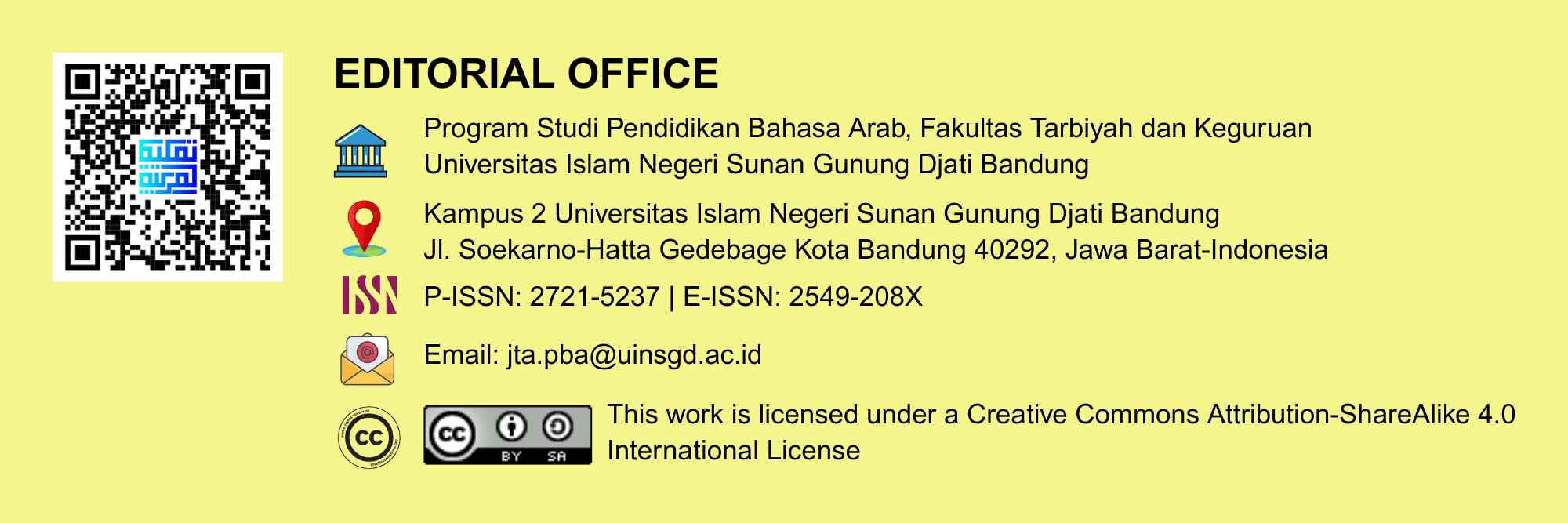The Communication Language Style of The Government of Kuwait During The Covid-19 Pandemic | Gaya Bahasa Komunikasi Pemerintah Kuwait di Masa Pandemi Covid-19
DOI:
https://doi.org/10.15575/jpba.v7i1.19054Keywords:
Communication, Dysphemism, Euphemism, Government of KuwaitAbstract
The purpose of this study is to describe that the Government of Kuwait, through its official social media, uses a lot of euphemistic and dysphemic language styles in conveying information in the era of the Covid-19 pandemic. This study uses a qualitative approach with content analysis to understand the symbolic messages contained in documents, paintings, dances, songs, literary works, and others as unstructured data. The data collection technique used is the observation and note-taking technique. Listening in the context of this study means reading, which is then recorded to document the data obtained. The data analysis technique used is the equivalent referential technique to find out grammatical units such as euphemisms and dysphemisms, while to analyze the background of the use of euphemisms and dysphemisms, pragmatic equivalent analysis is used. Based on the results of an analysis of data obtained from the official social media of the Ministry of Health of Kuwait, many euphemistic and dysphemistic forms were found in conveying information regarding the latest matters and developments regarding Covid-19 in the country of Kuwait. It is used for specific purposes. The purpose of using euphemistic forms is to avoid mentioning negative reality, which aims to minimize the harmful effects of utterances that seem scary, worrying, make noise, offend, hurt, disrespect, or violate social norms. Euphemistic forms also aim to evoke an optimistic attitude toward residents in dealing with the coronavirus pandemic. The use of the dysphemistic form used by the Kuwaiti Ministry of Health in presenting information about matters related to Covid-19 in that country is aimed at scaring, showing annoyance, and giving warnings so that they are even more vigilant in dealing with the Covid 19 pandemic.
References
Abdullah, N., & Abd. Rahman, L. (2019). Eufemisme dalam Wacana Terjemahan Makna Al-Quran ke Bahasa Melayu: Analisis Pragmatik: Euphemism in Malay Translation of Quranic Discourse: A Pragmatic Analysis. al-Irsyad: Journal of Islamic and Contemporary Issues, 4(1), 39–56. https://doi.org/10.53840/alirsyad.v4i1.46
Al-Azzam, B., Al-Ahaydib, M., Alkhowaiter, N., & Al-Momani, H. (2017). Social and Cultural Euphemism in Saudi Arabic: A Semantic, a Pragmatic and a Sociolinguistic Analysis. Advances in Language and Literary Studies, 8(2), 64–69. https://doi.org/10.7575/aiac.alls.v.8n.2p.64
Al-Dhoui, A.-D. M. (2022). Al-Lughah Maudhu’an linash al-Syi’ri ‘Inda Wadi’ Sa’adah. Majalah ’Ulum Lughah wa Adab, 1(1), 1–9. https://doi.org/10.21608/mala.2022.222929
Al-Haq, F. A., & Al-Smadi, M. (2020). Strategies of euphemism used by Jordanian University students. Jordan Journal of Modern Languages and Literatures, 12(3), 359–380. https://doi.org/10.47011/jjmll.12.3.6
Alotaibi, A. M. (2015). The Awareness of Euphemism by Kuwaiti Speakers of Arabic. International Journal of Linguistics, 7(1), 69–81. https://doi.org/10.5296/ijl.v7i1.6428
Alqahtani, S. M., Busabaa, N. A., & Salih, H. M. O. (2022). A Change in Saudi Attitudes From Use of Euphemism to Taboo: A Sociolinguistic Study. Journal of Language Teaching and Research, 13(3), 561–571. https://doi.org/10.17507/jltr.1303.12
Anggrianto, F. (2022). Analisis Wacana Kritis (Kajian Eufemisme dan Disfemisme dalam Wacana). CV Jejak Publisher.
Bani Mofarrej, O. M., & Al-Abed Al-Haq, F. (2015). A Sociolinguistic Study of Euphemistic Death Expressions in Jordanian Arabic. SSRN Electronic Journal, 6(2), 110–130. https://doi.org/10.2139/ssrn.2834381
Crespo-Fernández, E. (2014). Euphemisms and political discourse in the British regional press. Brno Studies in English, 40(1), 5–26. https://doi.org/10.5817/BSE2014-1-1
Daud, M. Z., Abd Wahid, M. S. N., & Gedat, R. (2018). Penggunaan Eufemisme dalam Kalangan Penutur Iban. International Journal of Language Education and Applied Linguistics, 8(1), 27–40. https://doi.org/10.15282/ijleal.v8.528
Eliya, I. (2017). Eufemisme Dan Disfemisme Dalam Catatan Najwa “Darah Muda Daerahâ€: Pola, Bentuk, Dan Makna. Deiksis: Jurnal Pendidikan Bahasa dan Sastra Indonesia, 4(2), 22–30. https://doi.org/10.33603/deiksis.v4i2.523
Eriyanti, R. W., Syarifuddin, K. T., Datoh, K., & Yuliana, E. (2020). Linguistik Umum. Uwais Inspirasi Indonesia.
Fadhilasari, I., & Ningtyas, G. R. (2021). Eufemisme dan Disfemisme dalam “Surat Terbuka Kepada DPR-RI†Narasi TV: Tinjauan Semantik. Jurnal Bahasa dan Sastra, 9(3), 201–213. https://doi.org/10.24036/jbs.v9i3.111833
Fahria, D. A. (2022). Eufemisme Dan Disfemisme Dalam Novel Burung-Burung Manyar Karya Yusuf Bilyarta Mangunwijaya (Euphemism And Disphemism In Yusuf Bilyarta Mangunwijaya’s Novel Burung-Burung Manyar). Jurnal Bahasa, Sastra Dan Pembelajarannya, 12(2), 359–376. https://doi.org/10.20527/jbsp.v12i2.14545
Gasana, J., & Shehab, M. (2020). Coronavirus Disease (COVID-19): Handling Challenges in Kuwait. Sci, 2(3), 1–9. https://doi.org/10.3390/sci2030063
Ghufron, Z. (2019). Bahasa dan Identitas Sosial. CV Penerbit 3M Media Karya.
Hirpan, M. Q., & Malthuf, A. (2020). Konsep at-TajnÄ«s menurut Ê»AlÄ« bin Ê»Abdul Ê»AzÄ«z al-JurjÄnÄ« dalam al-WasÄá¹ah baina al-MutanabbÄ« wa KhuṣūmihÄ«. Alfaz (Arabic Literatures for Academic Zealots), 8(1), 88–101. https://doi.org/10.32678/alfaz.Vol8.Iss1.2503
Inomovna, I. H., Gulyamovna, X. Z., & Ilhomjon Qizi, B. D. (2020). Classification and Types of Euphemisms. JournalNX - A Multidisciplinary Peer Reviewed Journal, 6(10), 53–57. https://repo.journalnx.com/index.php/nx/article/view/214
Jayanti, R. R., Maulida, N., & Musdolifah, A. (2019). Eufemisme dan Disfemisme Pada Judul Berita Surat Kabar Harian Balikpapan Pos Periode April-Mei 2018. Jurnal Basataka (JBT), 2(1), 77–86. https://doi.org/10.36277/basataka.v2i1.61
Li, B., & Xie, C. (2019). Sex in Language: Euphemistic and Dysphemistic Metaphors in Internet Forums. Australian Journal of Linguistics, 39(1), 145–148. https://doi.org/10.1080/07268602.2017.1291262
Meilasari, P., Nababan, N., & Djatmika, D. (2016). Analisis Terjemahan Ungkapan Eufemisme dan Disfemisme Pada Teks Berita Online BBC. Prasasti: Journal of Linguistics, 1(2), 336–358. https://doi.org/10.20961/prasasti.v1i2.1030
Mohd Shukor, R. binti, Mohd Rusli, N. F. binti, & Nallaluthan, K. (2021). Eufemisme dan Disfemisme dalam Komunikasi Pelajar berdasarkan Prinsip Kesantunan Leech: Eufemism and Dysphemism among Students’s Communication Based on Leech Politeness Principle. Pendeta: Journal of Malay Language, Education and Literature, 12(1), 1–10. https://doi.org/10.37134/pendeta.vol12.1.1.2021
Musthafa, I., & Hermawan, A. (2018). Metodologi Penelitian Bahasa Arab: Konsep Dasar Strategi Metode Teknik. Remaja Rosdakarya.
Nassar, M. M., & Al-Harahsheh, A. M. (2020). A Socio-Pragmatic Study of the Lebanese Uprising Slogans. International Journal of English and Education, 9(3), 174–184. https://ijee.org/assets/docs/16.18922605.pdf
Olimat, S. N. (2018). Developing a Model for Translating Euphemism in the Qur’an: An Intratextual- and Contextual-based Approach. Advances in Language and Literary Studies, 9(6), 101–111. https://doi.org/10.7575/aiac.alls.v.9n.6p.101
Ouzguid, K. (2019). The Representation of Euphemism in Moroccan Societal Discourse. Open Journal of Social Sciences, 7(6), 243–251. https://doi.org/10.4236/jss.2019.76020
Puspidalia, Y. S. (2018). Eufimisme dalam Dua Novel Duka Cinta sebagai Wujud Kesantunan Berbahasa. Jurnal Kodifikasia, 12(1), 141–153. https://doi.org/10.21154/kodifikasia.v12i1.1429
Ritos, S., & Daud, M. Z. (2020). Strategi Penggantian Disfemisme kepada Eufemisme dalam Komunikasi Lisan Masyarakat Bidayuh, Bau: Analisis Pragmatik. Asian People Journal (APJ), 3(1), 64–83. https://doi.org/10.37231/apj.2020.3.1.153
Rois, H. (2021). Eufemisme dan Disfemisme dalam Karangan Emha Ainun Nadjib: “Hidup Itu Harus Pintar Ngegas dan Ngerem.†Belajar Bahasa: Jurnal Ilmiah Program Studi Pendidikan Bahasa dan Sastra Indonesia, 6(1), 1–14. https://doi.org/10.32528/bb.v6i1.4031
Sagala, L. H. U. B. (2019). Kajian Eufemisme Dan Disfemisme Pada Komentar Para Netizen Dalamyoutube Berita Kumparan. Com (Edisi Menko Polhukam Wiranto Ditusuk Orang Di Pandeglang). Seminar Internasional Riksa Bahasa, 1, 539–548. Retrieved from http://proceedings2.upi.edu/index.php/riksabahasa/article/view/912
Sinambela, S. I., & Mulyadi, M. (2020). Analisis Eufemisme dan Disfemisme pada Detik.com di Twitter. Bahas, 30(1), 1–10. https://doi.org/10.24114/bhs.v30i1.16669
Terkourafi, M. (Ed.). (2016). The Linguistics of Politeness and Social Relations. Routledge, Taylor & Francis Group.
Wiharto, D., & Dewi, H. D. (2022). Eufemisme dan Disfemisme pada Teks Terjemahan Berita Merdeka.com: Analisis Wacana Kritis Berbasis Korpus. Lingua: Jurnal Ilmiah, 18(02), 100–118. https://doi.org/10.35962/lingua.v18i2.158
Zaharnika, R. F. A., & Nazirun, N. (2023). Eufemisme dalam Wacana Berita Online Riau Pos. Com. J-LELC: Journal of Language Education, Linguistics, and Culture, 3(1), 63–72. https://doi.org/10.25299/j-lelc.v3i1.12095
Downloads
Published
How to Cite
Issue
Section
Citation Check
License
Authors who publish in Ta'lim al-'Arabiyyah: Jurnal Pendidikan Bahasa Arab dan Kebahasaaraban agree to the following terms:
- Authors retain copyright and grant the journal right of first publication with the work simultaneously licensed under a Creative Commons Attribution-ShareAlike 4.0 International (CC BY-SA 4.0) License that allows others to share the work with an acknowledgment of the work's authorship and initial publication in this journal.
- Authors are able to enter into separate, additional contractual arrangements for the non-exclusive distribution of the journal's published version of the work (e.g., post it to an institutional repository or publish it in a book), with an acknowledgment of its initial publication in this journal.
- Authors are permitted and encouraged to post their work online (e.g., in institutional repositories or on their website) prior to and during the submission process, as it can lead to productive exchanges, as well as earlier and greater citation of published work (See The Effect of Open Access).
![]()
Ta'lim al-'Arabiyyah: Jurnal Pendidikan Bahasa Arab dan Kebahasaaraban is licensed under a Creative Commons Attribution-ShareAlike 4.0 International License.
Based on a work at https://journal.uinsgd.ac.id/index.php/Talim








